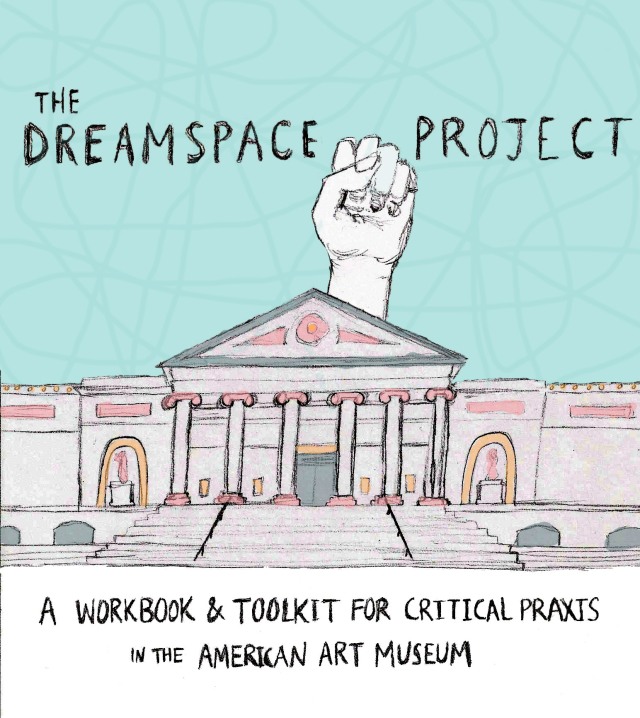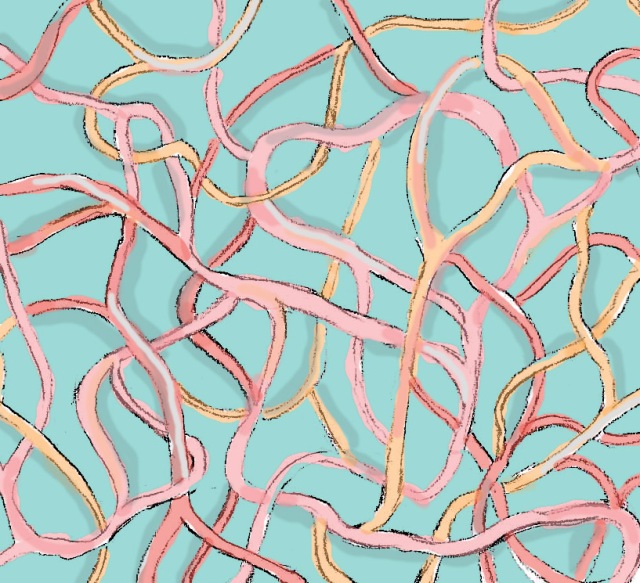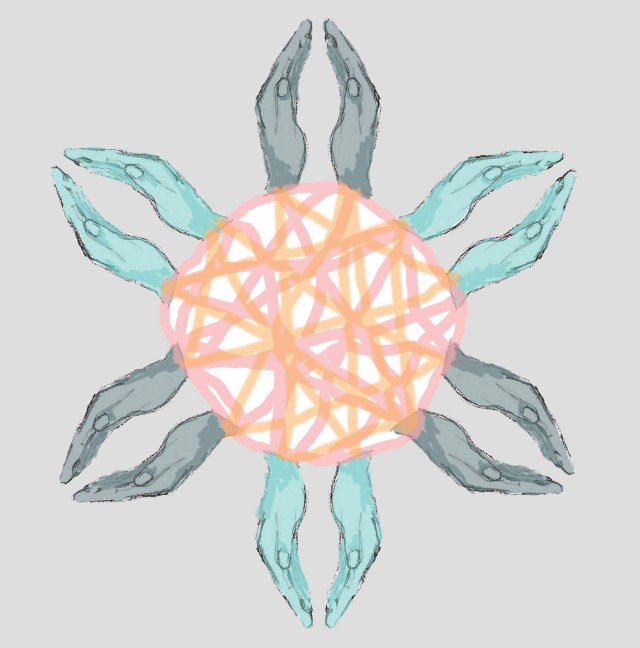We are excited to feature the work of Alyssa Machida who, over the last couple years, has been weaving theory through practice to develop a workbook and toolkit entitled: “The Dreamspace Project: A Workbook and Toolkit for Critical Praxis in the American Art Museum.” In this first blogpost out of a three part series, Alyssa introduces us to the workbook and what motivated its creation. In upcoming posts, we will feature previews of this timely workbook…so stay tuned! Many thanks to Alyssa for channeling so much energy into creating this important workbook and for her willingness to share it with us here on the Incluseum. (The PDF version of the Workbook can be accessed here and the Live Google Presentation of the Workbook is here.)
* * * *
There is a growing need for tools and resources to guide museum educators in developing more nuanced understandings of race and racism throughout their institutions. As an arts educator, I have been investigating how integrating concepts from critical pedagogy, critical race theory, and ethnic studies can deepen my practice and help me navigate these issues. When discussing strategies to share my findings, I often receive the suggestion of creating a handout or worksheet easy to comprehend and accommodate for museum staff who might not have the time to delve into theory. While meticulous adherence to theory is not necessary to be a good educator, I want to foreground that surface-level understandings of social issues will only produce surface-level results. If we truly want to address the issues plaguing our society, we cannot be content with simply adopting politically correct language and doing our best not to offend. Dismantling institutionalized racism is time-consuming and painful, and it is not something that any handout (or even this book) will ever solve on its own. In support of this ongoing struggle, I am currently working on “The Dreamspace Project: A workbook and toolkit for critical praxis[1] in the American art museum.” This workbook translates theoretical concepts into practical language and frameworks adaptable for art museum professionals with key vocabulary, diagrams and graphic organizers, ideas for building tours, and questions for critical reflection.

Credit: Chelsea Brendle
This work is an extension of my practice as an art museum educator, combined with the research I began this past year as a master’s student focusing on the intersections between arts, education, and activism. The intended audience for this resource is art museum educators, professionals, and staff, as the content will support our collective journey in improving institutional practices. The format of the workbook was chosen to a) allow for self-paced, analytic and reflective individual work, b) generate documentation by learners, and c) maximize agency over the content of the workbook which includes the sections:
- Contextualizing: Mapping and Navigating Terrains
- Deconstruction
- Decolonization
- Democratization and Constructing Public-ness
- Radical Imagination and Critical Action
- Future Beginnings
These sections were developed to lead learners through a process of deepening understanding of connections between individual identities and roles to larger social dynamics. We must begin here with knowledge and understanding of historical and contemporary contexts of racism and systemic oppression within our society. Then, we need to come to terms with how we are implicated in these systems and why it is imperative we act against them. The final chapter will guide readers to see the ways they have agency with this new knowledge in activating personal and institutional growth.
This workbook takes educators through a significant amount of content for the purpose of raising critical consciousness. A frequent argument I hear to learning about racism is, “Why is this even necessary? This is unrelated to what I do. I’m not a racist.” Working in art museums as educators, I understand that our day-to-day responsibilities consist primarily of leading school groups through the galleries and facilitating art activities. Our visitors do not necessarily come to the art museum to learn more about social justice issues. However, the work we do of becoming authentic, responsible, culturally relevant [2]educators engages us in wide-reaching social forces and dynamics beyond our peripheral vision, teaching us how to become better human beings in the process. If we want to be better, the first step is acknowledging difficult truths so that we may begin to separate ourselves from persisting them.
The workbook begins from the inarguable premise that to live in the United States in the modern day is to be complicit within a network of systems of oppression including, but not limited to:
- Racism/White Supremacy
- Western-centrism
- Patriarchy
- Heteronormativism
- Cisgenderism
- Ableism
- Capitalism
- Colonialism
- Classism/Privilege
Whether or not one sees themselves as implicated in any one of these, they are all interwoven throughout the fabric of our society in a global system of dominance and subordination. Housing discrimination, forced evictions, access to health care, marriage inequality, immigration rights, genocide, the refugee crisis, human trafficking, torture, poverty and unemployment, police violence, mass incarceration, the failure of the public school system … who is allowed to have rights, who has voice, and who has representation? Who has capital, who has property, and whose bodies are considered to have value or worth? As educators and professionals hoping to better serve diverse publics, it is essential that we understand the gravity and urgency of these issues in full because these systems in our society at large are also at work in art museums as well. This workbook begins and ends with exercises of critical investigation of how these systems work against us, and also how these systems work in our favor.
The process of critical self-examination in The Dreamspace Project was inspired by the essay, “To search for the good and make it matter” by Estella Conwill Májozo. I found this particular section most captivating:
“The dream space of the soul is the real terrain that we should map. If not, then nothing else that we are fighting for or against has any possibility of transformation … None of these concerns can be taken on unless they are examined, acknowledged, and confronted within the inner territory of the self, the earth that, in fact, we are. The soul is the seedbed of our actions. Everything that we conceptualize, create, or destroy has its beginnings there” (1995, p.88).

Credit: Chelsea Brendle
I return to this text again and again to reflect on her description of what seems like a forgotten harmony and connectivity between ourselves, to one another, and the earth. As I thought about this piece in relation to my work in art museums, an important message emerged. I often find myself in conversations about community outreach, extending the art museum to diverse audiences. The trajectory of speech and perspective is external. With The Dreamspace Project, I take the approach that we can only truly extend ourselves as far as we have dared to examine and interrogate inward; to cast an eye not only upon the world and others, but to spend time critically studying ourselves and the many layers and identities we hold. I have come to realize that the bulk of the “work” we must engage in is primarily self-work.
To pursue critical individual and institutional practice, it is essential to turn our outreach inwards, and to examine and challenge in hopes of removing hierarchies. We often speak of our work in the American art museum, and as cultural citizens of the world, as educating and enriching the lives of the public. But I no longer consider these with any degree of certainty; whether as action-verbs or even results. They are purely hopes and visions for the future that drive this work forward. Rather than presupposing that it is the art museum that contains the wealth of knowledge and experience, we must remember that the participation of diverse museum goers enrich the experiences that happen within museum walls. To be authentic in our endeavors for inclusion, we must push ourselves and each other beyond surface-level understandings, assuming best intentions, and utilizing politically correct rhetoric. Aboriginal elder and activist Lilla Watson spoke of the necessary humility in the fight for social justice:
“If you have come to help me, you are wasting your time. But if you have come because your liberation is bound up with mine, then let us work together.” – Aboriginal activists group, Queensland
Májozo also wrote of how we often envision sites of activism and social change as outside, in the world, and sometimes far away from our own lives. However, she argues that the transformation of society is inextricably linked to our transformation of ourselves. It is the many terrains within that we must examine and interrogate before we consider any impact on the world.
One essential stance of this workbook is that it does not claim or guarantee social impact. The Dreamspace Project is a tool for rigorous self-study and examining our practice as art museum educators in the contemporary world. This is about interrogating ourselves and our work with a critical lens to ignite a process of reflective growth within our institutions. This work is not, however, about how art museums can “make a difference” in the world. A formative text for this workbook has been “Why the Arts Don’t Do Anything: Toward a New Vision for Cultural Production in Education” by scholar Rubén A. Gaztambide-Fernández. He asserts:
experiences with artistic forms cannot be guaranteed; even with the most carefully planned arts-based interventions, an experience cannot be predicted or planned or assumed to be good just because it involves something called ‘the arts’ (2013, p. 231).
His work is a consistent reminder to not get carried away with claims of what our work in art museums does or what effects it will have. Especially when discussing current events and social issues such as police violence, the refugee crisis, and mass killings, we must be aware that we are not conflating our well-meaning intentions with actual solutions to these issues. There is a massive gap between the environment of the art museum and the daily realities of public life. Changing the filter on a Facebook profile to a state or national flag is not enough. Flying our flags at half-mast is not enough. Calling out for empathy is not enough. Facilitating “critical” conversations is not enough. We have to avoid savior-mentalities and continue challenging ourselves to be braver, to get uncomfortable, and push ourselves beyond our unearned privilege of safety and comfort. The American art museum is a tangled knot of hierarchy and oppression. If we believe in arts and education for the public, we need to face reality and start untangling these knots. The tragedies we face are symptoms of deep-rooted problems within the United States. One thing we can do, is begin with ourselves.
Many times I have heard of people wanting to maintain separation between their personal and work lives. I have often heard analytical level-headedness conflated with objectivity. But with the work done through The Dreamspace Project, I encourage people to be political, emotional, and subjective. It is a delusion to assume that our work within art museums is neutral to begin with. The purpose of this workbook is to gain comprehensive understandings of our own practice, our motivations and biases, our relationship to systemic oppression in daily lives, and how this process can empower ourselves and others to counteract these streams. It is time to act boldly, for us to push the American art museum to stand in collective solidarity alongside the people.
This blogpost will continue over two subsequent parts coming soon. Part two will go over Contextualizing, Deconstruction, and Decolonization, and part three will discuss Democratization, Radical Imagination and Critical Action, and Future Beginnings, concluding with information regarding next steps for the project. In the meantime, please feel free to get in touch at dreamspaceworkbook@gmail.com.
[1] Refers to the concept of praxis described by Paulo Freire in Pedagogy of the Oppressed as an iterative process of critical reflection and action to fuel social transformation. This is tied to the notion of conscientização, or critical consciousness, and is used here specifically in relation to liberatory educational practices.
[2] Refers to Gloria Ladson-Billings’ concept of culturally relevant pedagogy and will be discussed further in the section on Deconstruction.
REFERENCES
Freire, P. (2014). Pedagogy of the Oppressed (30th Anniversary Edition). London: Bloomsbury Publishing.
Gaztambide-Fernández, R. (2013). Why the Arts Don’t Do Anything: Toward a New Vision for Cultural Production in Education. Harvard Educational Review, 83(1), 211-236,265.
Májozo, E. (1995). To search for the good and make it matter. In S. Lacy (Ed.), Mapping the terrain: New genre public art. Seattle, Wash.: Bay Press.
Alyssa Machida is an arts educator born and raised in Santa Monica, California. Her work focuses on critical teaching methodologies, issues of racial equity and social justice, and designing experiences to ignite active learning for diverse audiences. Her research interests are situated at the intersection of arts, education, and activism and she is passionate about establishing critical learning and teaching practices in art museums. She earned her B.A. in History of Art at the University of California, Berkeley (2013) and her Ed.M. in Arts in Education at the Harvard Graduate School of Education (2016). Most recently, Alyssa has started her new job as Interpretive Specialist at the Detroit Institute of Arts working primarily on the reinstallation of the DIA’s Asian art galleries.


Thank you for sharing this exciting and important work with the world. The workbook format for reflecting on these issues is brilliant! I can’t wait to share and discuss your posts with my university museum colleagues, interns, and students. Many thanks!
[…] We are excited to feature the work of Alyssa Machida who, over the last couple years, has been weaving theory through practice to develop a workbook and toolkit entitled: “The Dreamspace Project: A Workbook and Toolkit for Critical Praxis in the American Art Museum.” In this second blogpost of a three part series, Alyssa continues to share previews of this timely workbook… so stay tuned for more! Many thanks to Alyssa for channeling so much energy into creating this important workbook and for her willingness to share it with us here on the Incluseum. You can read Part 1 of this series here. […]
[…] and Alyssa Machida to share the materials they gave us. Also, the first part of the Dreamscape workbook can be read […]
[…] to the blogs I referred to: http://labs.aam-us.org/blog/building-dreamspace-in-museum-education/ https://incluseum.com/2016/08/11/a-workbook-and-toolkit-for-critical-praxis-in-the-american-art-muse… […]
[…] strongly encourage you to learn more about Alyssa’s work on the Incluseum here: Dreamspace Blog Post 1 and Dreamspace Blog Post 2 and to listen to Alyssa talk through her work on the great new podcast […]
[…] for her willingness to share it with us here on the Incluseum. You can read Part 1 of the series here and Part 2 here. (The PDF version of the Workbook can be accessed here and the Live Google […]
[…] Dreamspace Project by Alyssa Machida Part 1 (link here) Part 2 (link here), and Part 3 (link […]
[…] to the blogs I referred to: http://labs.aam-us.org/blog/building-dreamspace-in-museum-education/ https://incluseum.com/2016/08/11/a-workbook-and-toolkit-for-critical-praxis-in-the-american-art-muse… […]
[…] to the blogs I referred to: http://labs.aam-us.org/blog/building-dreamspace-in-museum-education/ https://incluseum.com/2016/08/11/a-workbook-and-toolkit-for-critical-praxis-in-the-american-art-muse… […]